Hanqi Yan
Soft Reasoning: Navigating Solution Spaces in Large Language Models through Controlled Embedding Exploration
May 30, 2025Abstract:Large Language Models (LLMs) struggle with complex reasoning due to limited diversity and inefficient search. We propose Soft Reasoning, an embedding-based search framework that optimises the embedding of the first token to guide generation. It combines (1) embedding perturbation for controlled exploration and (2) Bayesian optimisation to refine embeddings via a verifier-guided objective, balancing exploration and exploitation. This approach improves reasoning accuracy and coherence while avoiding reliance on heuristic search. Experiments demonstrate superior correctness with minimal computation, making it a scalable, model-agnostic solution.
SciReplicate-Bench: Benchmarking LLMs in Agent-driven Algorithmic Reproduction from Research Papers
Mar 31, 2025Abstract:This study evaluates large language models (LLMs) in generating code from algorithm descriptions from recent NLP papers. The task requires two key competencies: (1) algorithm comprehension: synthesizing information from papers and academic literature to understand implementation logic, and (2) coding expertise: identifying dependencies and correctly implementing necessary APIs. To facilitate rigorous evaluation, we introduce SciReplicate-Bench, a benchmark of 100 tasks from 36 NLP papers published in 2024, featuring detailed annotations and comprehensive test cases. Building on SciReplicate-Bench, we propose Sci-Reproducer, a multi-agent framework consisting of a Paper Agent that interprets algorithmic concepts from literature and a Code Agent that retrieves dependencies from repositories and implement solutions. To assess algorithm understanding, we introduce reasoning graph accuracy, which quantifies similarity between generated and reference reasoning graphs derived from code comments and structure. For evaluating implementation quality, we employ execution accuracy, CodeBLEU, and repository dependency/API recall metrics. In our experiments, we evaluate various powerful Non-Reasoning LLMs and Reasoning LLMs as foundational models. The best-performing LLM using Sci-Reproducer achieves only 39% execution accuracy, highlighting the benchmark's difficulty.Our analysis identifies missing or inconsistent algorithm descriptions as key barriers to successful reproduction. We will open-source our benchmark, and code at https://github.com/xyzCS/SciReplicate-Bench.
Beyond Prompting: An Efficient Embedding Framework for Open-Domain Question Answering
Mar 03, 2025



Abstract:Large language models have recently pushed open domain question answering (ODQA) to new frontiers. However, prevailing retriever-reader pipelines often depend on multiple rounds of prompt level instructions, leading to high computational overhead, instability, and suboptimal retrieval coverage. In this paper, we propose EmbQA, an embedding-level framework that alleviates these shortcomings by enhancing both the retriever and the reader. Specifically, we refine query representations via lightweight linear layers under an unsupervised contrastive learning objective, thereby reordering retrieved passages to highlight those most likely to contain correct answers. Additionally, we introduce an exploratory embedding that broadens the model's latent semantic space to diversify candidate generation and employs an entropy-based selection mechanism to choose the most confident answer automatically. Extensive experiments across three open-source LLMs, three retrieval methods, and four ODQA benchmarks demonstrate that EmbQA substantially outperforms recent baselines in both accuracy and efficiency.
CODI: Compressing Chain-of-Thought into Continuous Space via Self-Distillation
Feb 28, 2025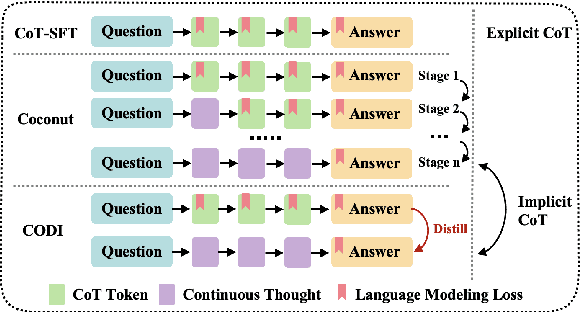
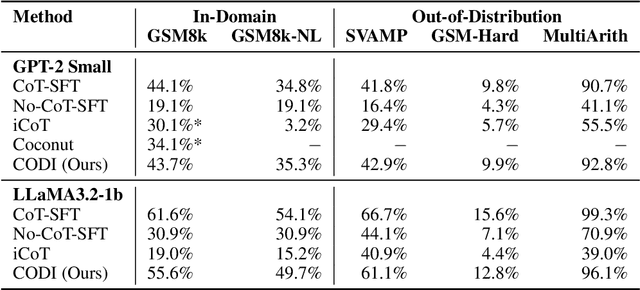
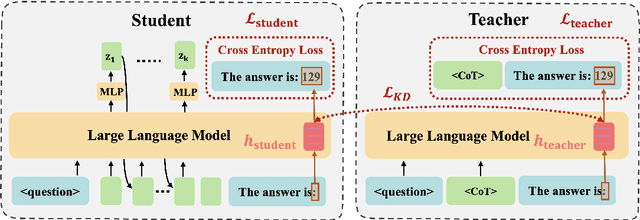
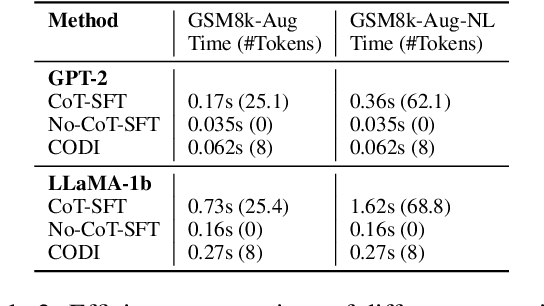
Abstract:Chain-of-Thought (CoT) enhances Large Language Models (LLMs) by enabling step-by-step reasoning in natural language. However, the language space may be suboptimal for reasoning. While implicit CoT methods attempt to enable reasoning without explicit CoT tokens, they have consistently lagged behind explicit CoT method in task performance. We propose CODI (Continuous Chain-of-Thought via Self-Distillation), a novel framework that distills CoT into a continuous space, where a shared model acts as both teacher and student, jointly learning explicit and implicit CoT while aligning their hidden activation on the token generating the final answer. CODI is the first implicit CoT method to match explicit CoT's performance on GSM8k while achieving 3.1x compression, surpassing the previous state-of-the-art by 28.2% in accuracy. Furthermore, CODI demonstrates scalability, robustness, and generalizability to more complex CoT datasets. Additionally, CODI retains interpretability by decoding its continuous thoughts, making its reasoning process transparent. Our findings establish implicit CoT as not only a more efficient but a powerful alternative to explicit CoT.
Direct Preference Optimization Using Sparse Feature-Level Constraints
Nov 12, 2024



Abstract:The alignment of large language models (LLMs) with human preferences remains a key challenge. While post-training techniques like Reinforcement Learning from Human Feedback (RLHF) and Direct Preference Optimization (DPO) have achieved notable success, they often introduce computational inefficiencies and training instability. In this paper, we propose Feature-level constrained Preference Optimization (FPO), a novel method designed to simplify the alignment process while ensuring stability. FPO leverages pre-trained Sparse Autoencoders (SAEs) and introduces feature-level constraints, allowing for efficient, sparsity-enforced alignment. Our approach enjoys efficiency by using sparse features activated in a well-trained sparse autoencoder and the quality of sequential KL divergence by using the feature-level offline reference. Experimental results on benchmark datasets demonstrate that FPO achieves a 5.08% absolute improvement in win rate with much lower computational cost compared to state-of-the-art baselines, making it a promising solution for efficient and controllable LLM alignments.
Weak Reward Model Transforms Generative Models into Robust Causal Event Extraction Systems
Jun 27, 2024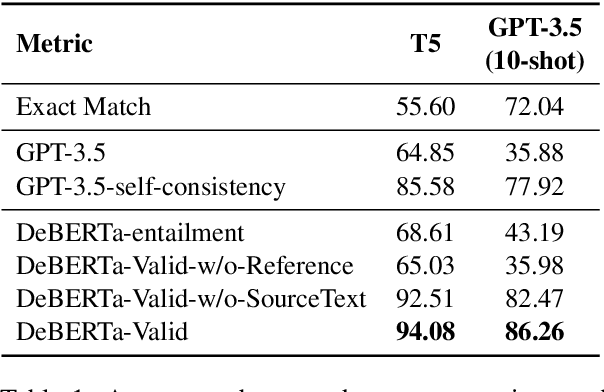
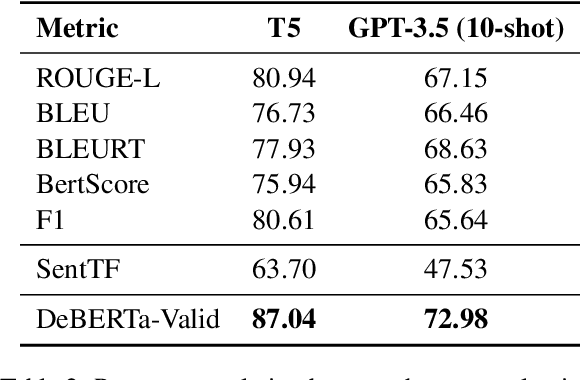
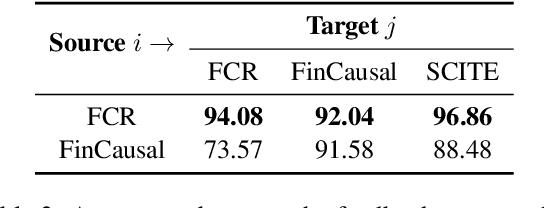
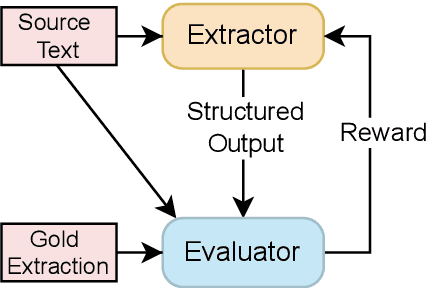
Abstract:The inherent ambiguity of cause and effect boundaries poses a challenge in evaluating causal event extraction tasks. Traditional metrics like Exact Match and BertScore poorly reflect model performance, so we trained evaluation models to approximate human evaluation, achieving high agreement. We used them to perform Reinforcement Learning with extraction models to align them with human preference, prioritising semantic understanding. We successfully explored our approach through multiple datasets, including transferring an evaluator trained on one dataset to another as a way to decrease the reliance on human-annotated data. In that vein, we also propose a weak-to-strong supervision method that uses a fraction of the annotated data to train an evaluation model while still achieving high performance in training an RL model. Our code is available at https://github.com/oyarsa/event_extraction/tree/causal-event-extraction.
Encourage or Inhibit Monosemanticity? Revisit Monosemanticity from a Feature Decorrelation Perspective
Jun 25, 2024
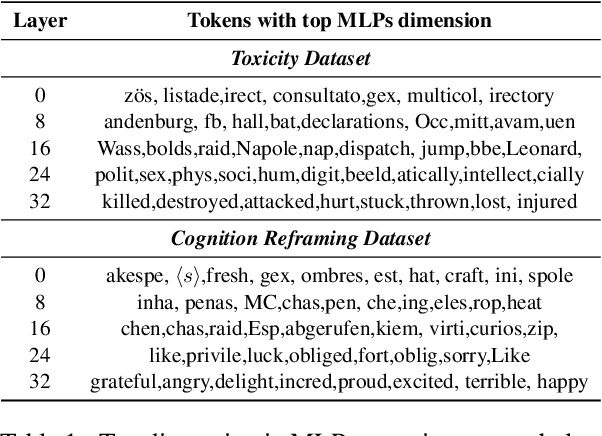
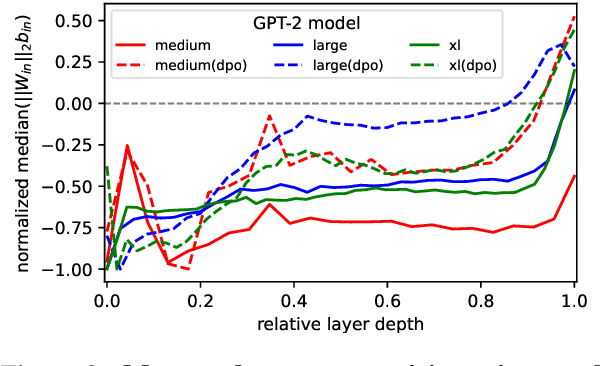

Abstract:To better interpret the intrinsic mechanism of large language models (LLMs), recent studies focus on monosemanticity on its basic units. A monosemantic neuron is dedicated to a single and specific concept, which forms a one-to-one correlation between neurons and concepts. Despite extensive research in monosemanticity probing, it remains unclear whether monosemanticity is beneficial or harmful to model capacity. To explore this question, we revisit monosemanticity from the feature decorrelation perspective and advocate for its encouragement. We experimentally observe that the current conclusion by wang2024learning, which suggests that decreasing monosemanticity enhances model performance, does not hold when the model changes. Instead, we demonstrate that monosemanticity consistently exhibits a positive correlation with model capacity, in the preference alignment process. Consequently, we apply feature correlation as a proxy for monosemanticity and incorporate a feature decorrelation regularizer into the dynamic preference optimization process. The experiments show that our method not only enhances representation diversity and activation sparsity but also improves preference alignment performance.
Addressing Order Sensitivity of In-Context Demonstration Examples in Causal Language Models
Feb 23, 2024Abstract:In-context learning has become a popular paradigm in natural language processing. However, its performance can be significantly influenced by the order of in-context demonstration examples. In this paper, we found that causal language models (CausalLMs) are more sensitive to this order compared to prefix language models (PrefixLMs). We attribute this phenomenon to the auto-regressive attention masks within CausalLMs, which restrict each token from accessing information from subsequent tokens. This results in different receptive fields for samples at different positions, thereby leading to representation disparities across positions. To tackle this challenge, we introduce an unsupervised fine-tuning method, termed the Information-Augmented and Consistency-Enhanced approach. This approach utilizes contrastive learning to align representations of in-context examples across different positions and introduces a consistency loss to ensure similar representations for inputs with different permutations. This enhances the model's predictive consistency across permutations. Experimental results on four benchmarks suggest that our proposed method can reduce the sensitivity to the order of in-context examples and exhibit robust generalizability, particularly when demonstrations are sourced from a pool different from that used in the training phase, or when the number of in-context examples differs from what is used during training.
Counterfactual Generation with Identifiability Guarantees
Feb 23, 2024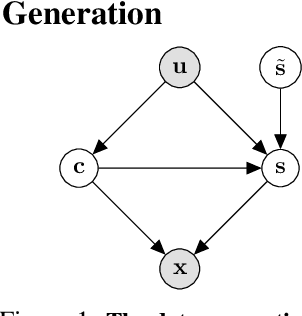
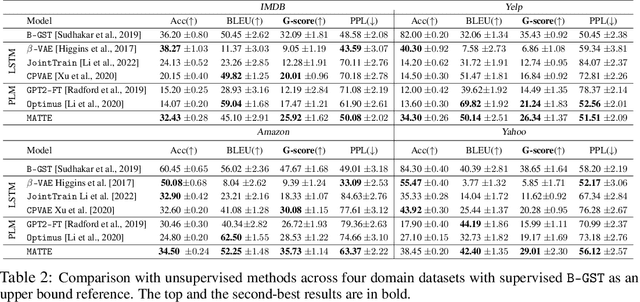
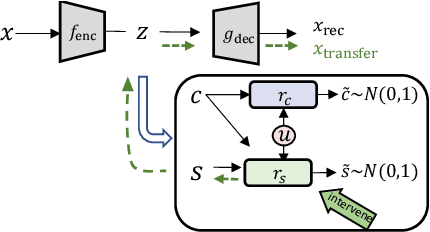
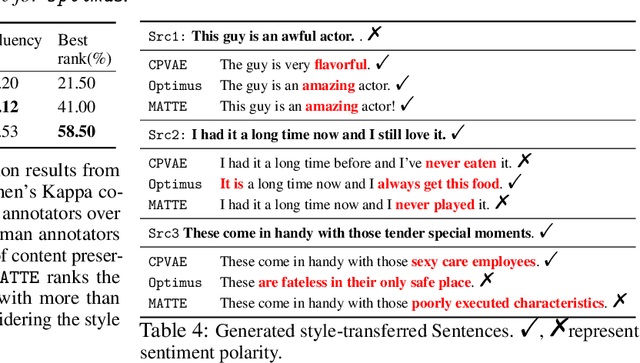
Abstract:Counterfactual generation lies at the core of various machine learning tasks, including image translation and controllable text generation. This generation process usually requires the identification of the disentangled latent representations, such as content and style, that underlie the observed data. However, it becomes more challenging when faced with a scarcity of paired data and labeling information. Existing disentangled methods crucially rely on oversimplified assumptions, such as assuming independent content and style variables, to identify the latent variables, even though such assumptions may not hold for complex data distributions. For instance, food reviews tend to involve words like tasty, whereas movie reviews commonly contain words such as thrilling for the same positive sentiment. This problem is exacerbated when data are sampled from multiple domains since the dependence between content and style may vary significantly over domains. In this work, we tackle the domain-varying dependence between the content and the style variables inherent in the counterfactual generation task. We provide identification guarantees for such latent-variable models by leveraging the relative sparsity of the influences from different latent variables. Our theoretical insights enable the development of a doMain AdapTive counTerfactual gEneration model, called (MATTE). Our theoretically grounded framework achieves state-of-the-art performance in unsupervised style transfer tasks, where neither paired data nor style labels are utilized, across four large-scale datasets. Code is available at https://github.com/hanqi-qi/Matte.git
Mirror: A Multiple-perspective Self-Reflection Method for Knowledge-rich Reasoning
Feb 22, 2024
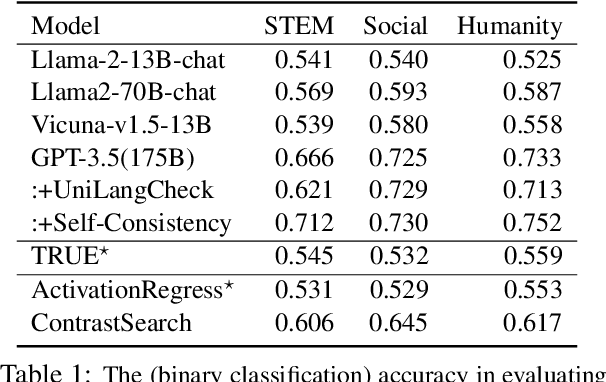

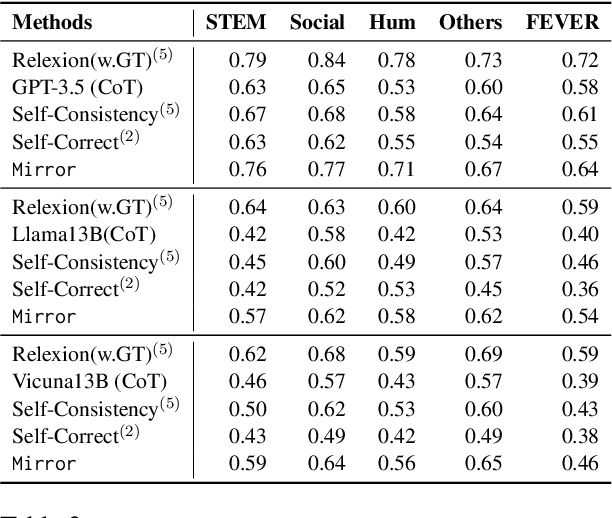
Abstract:While Large language models (LLMs) have the capability to iteratively reflect on their own outputs, recent studies have observed their struggles with knowledge-rich problems without access to external resources. In addition to the inefficiency of LLMs in self-assessment, we also observe that LLMs struggle to revisit their predictions despite receiving explicit negative feedback. Therefore, We propose Mirror, a Multiple-perspective self-reflection method for knowledge-rich reasoning, to avoid getting stuck at a particular reflection iteration. Mirror enables LLMs to reflect from multiple-perspective clues, achieved through a heuristic interaction between a Navigator and a Reasoner. It guides agents toward diverse yet plausibly reliable reasoning trajectory without access to ground truth by encouraging (1) diversity of directions generated by Navigator and (2) agreement among strategically induced perturbations in responses generated by the Reasoner. The experiments on five reasoning datasets demonstrate that Mirror's superiority over several contemporary self-reflection approaches. Additionally, the ablation study studies clearly indicate that our strategies alleviate the aforementioned challenges.
 Add to Chrome
Add to Chrome Add to Firefox
Add to Firefox Add to Edge
Add to Edge